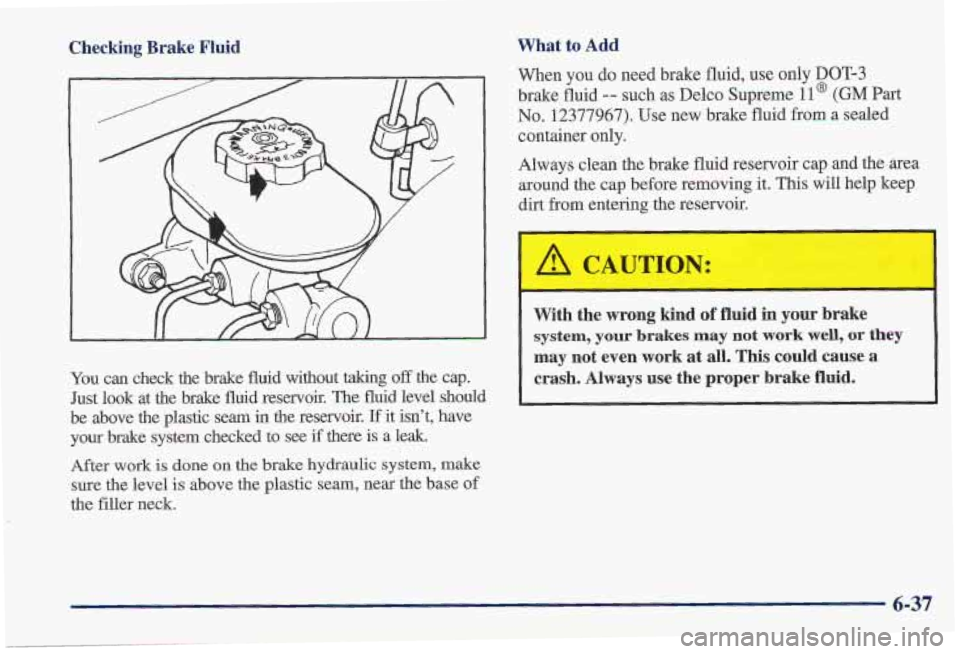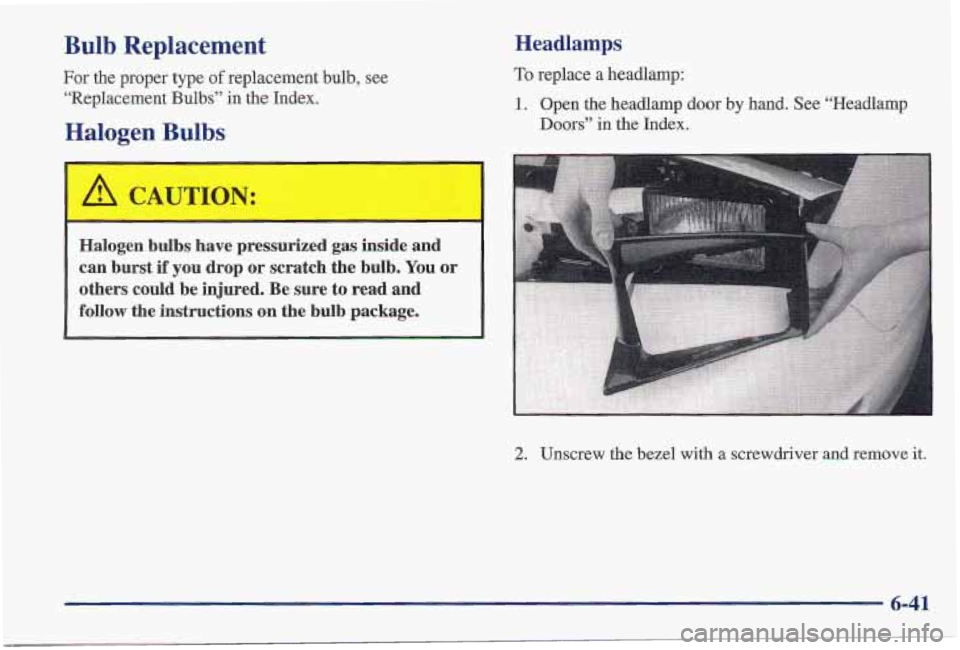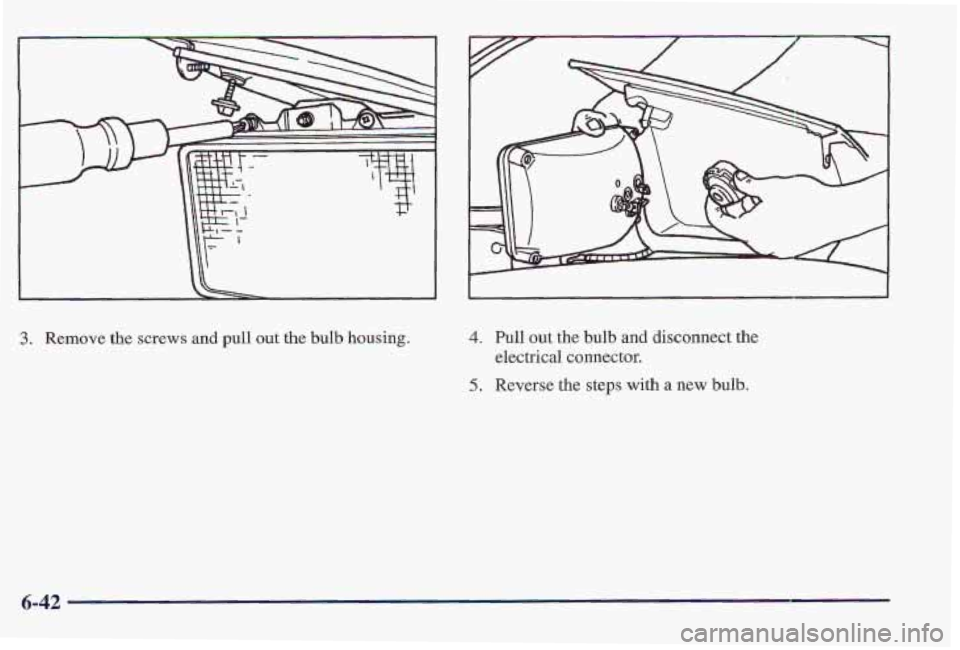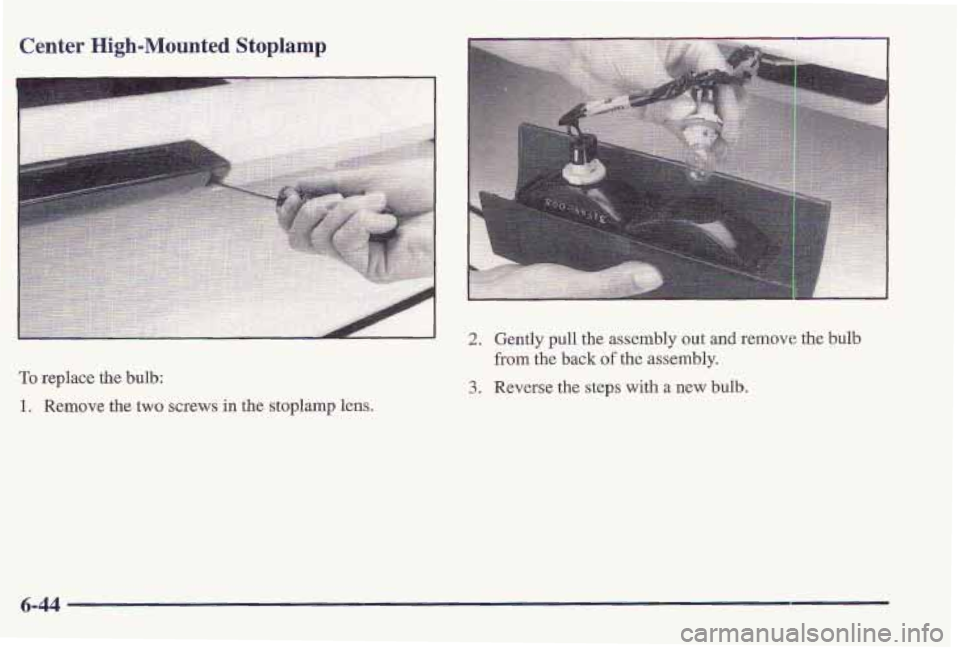PONTIAC FIREBIRD 1997 Owners Manual
Manufacturer: PONTIAC, Model Year: 1997, Model line: FIREBIRD, Model: PONTIAC FIREBIRD 1997Pages: 410, PDF Size: 19.2 MB
Page 281 of 410

Brakes
Brake Fluid
of the brake system. If it is, you should have your brake
system fixed, since
a leak means that sooner or later your
brakes wonât work well, or wonât work at all.
So, it isnât a good idea to âtop offâ your brake fluid.
Adding brake fluid wonât correct a leak. If you add fluid
when your linings are worn, then youâll have too
much
fluid when you get new brake linings. You should add
(or remove) brake fluid, as necessary, only when work is
done on the brake hydrwlic system.
Your brake master cylinder reservoir is here.
It is filled
with
DOT-3 brake fluid.
There are only two reasons why
the brake fluid level in the
reservoir might go down. The first is that the brake fluid
goes down to
an acceptable level during normal brake
lining wear, When new linings are put in, the fluid level
goes back up. The other reason is that fluid is leaking out
If you have too much brake fluid, it can spill
on the engine. The fluid will burn if the engine
is hot enough. You âor others could be burned,
and your vehicle could be damaged. Add brake
fluid only
when work is done on the brake
hydraulic system.
Refer to the Maintenance Schedule to determine when to
check your brake fluid.
See âPeriodic Maintenance
Inspectionsâ in the
Index.
6-36
Page 282 of 410

Checking Brake Fluid
You can check the brake fluid without taking off the cap.
Just look at the brake fluid reservoir. The fluid level should
be above the plastic seam
in the reservoir. If it isnât, have
your brake system checked
to see if there is a leak.
After work
is done on the brake hydraulic system, make
sure the level is above the plastic seam, near the base of
the filler neck.
What to Add
When you do need brake fluid, use only DOT-3
brake fluid -- such as Delco Supreme 11 @ (GM Part
No. 12377967). Use new brake fluid from a sealed
container only.
Always clean the brake fluid reservoir cap and the area
around the cap before removing
it. This will help keep
dirt from entering the reservoir.
With the wrong kind of fluid in your brake
system, your brakes may not work well, or they
may not even work at all. This could cause a
crash. Always use the proper brake fluid.
6-37
Page 283 of 410

NOTICE:
Using the wrong fluid can badly damage
brake system parts. For example, just a few
drops
of mineral-based oil, such as engine
oil, in your brake system can damage brake
system parts
so badly that theyâll have to be
replaced.
Donât let someone put in the
wrong
kind of fluid.
0 If you spill brake fluid on your vehicleâs
painted surfaces, the paint finish can
be
damaged. Be careful not to spill brake
fluid
on your vehicle. If you do, wash it
off immediately. See âAppearance Careââ
in the Index.
Brake Wear
Unless you have the four-wheel disc brake option, your
Pontiac has front disc brakes and rear
drum brakes.
Disc brake pads have built-in wear indicators that
make a high-pitched warning sound
when the brake
pads are worn and new pads are needed.
The sound
may come
and go or be heard all the time your vehicle
is moving (except when you are pushing
on the brake
pedal firmly).
I
The brake wear warning sound means that soon
your brakes wonât work well. That could lead to
an accident. When
you hear the brake wear
warning sound, have
your vehicle serviced.
6-38
Page 284 of 410

Brake linings should always be replaced as complete
See
âBrake System Inspectionâ in Section 7 of this
NOTICE: axle sets.
Continuing to drive with worn-out brake pads
Inspectionsâ. could result in costly brake repair.
manual under Part C âPeriodic Maintenance
Same driving conditions or climates may cause a brake
squeal when the brakes are. first applied or lightly
applied. This does not mean something is wrong with
your brakes.
See âCaliper/Knuckle Maintenance Inspectionââ in
Section
7 of this manual under Part C âPeriodic
Maintenance Inspections.â
If you have rear drum brakes, they donât have wear
indicators, but
if you ever hear a rear brake rubbing
noise, have the rear brake linings inspected. Also, the
rear brake drums should
be removed and inspected each
time the tires are removed for rotation or changing.
When
you have the front brakes replaced, have the rear
brakes inspected, too.
Brake Pedal Travel
See your dealer if the brake pedal does not return to
normal height, or if there is a rapid increase in pedal
travel.
This could be a sign of brake trouble.
Brake Adjustment
Every time you make a moderate brake stop, your disc
brakes adjust for wear.
If you rarely make a moderate or
heavier stop, then your brakes might not adjust correctly.
If you drive in that way, then -- very carefully -- make
a few moderate brake stops about every 1,000 miles
(1 600 km), so your brakes will adjust properly.
If your brake pedal goes down farther than normal, your
rear drum brakes may need adjustment. Adjust them by
backing up and firmly applying the brakes
a few times.
6-39
Page 285 of 410

Replacing Brake System Parts
The braking system on a modern vehicle is complex. Its
many parts have to be of top quality and work well
together if the vehicle is to have really good braking.
Vehicles we design and test have top-quality
GM brake
parts in them, as your Pontiac does when
it is new.
When you replace parts
of your braking system -- for
example, when your brake linings wear down and you
have to have new ones put in
-- be sure you get new
genuine
GM replacement parts. If you donât, your
brakes may no longer work properly. For example, if
someone puts in brake linings that are wrong for your
vehicle, the balance between your front and rear brakes
can change
-- for the worse. The braking performance
youâve come
to expect can change in many other ways if
someone puts in the wrong replacement brake parts.
Battery
Every new Pontiac has a Delco Freedom@ battery. You
never have to add water to one of these. When itâs time
for a new battery, we recommend a Delco Freedom
battery. Get
one that has the replacement number shown
on the original batteryâs label.
Vehicle Storage
If youâre not going to drive your vehicle for 25 days
or more, take off the black, negative
(-) cable from
the battery. This will help keep your battery from
running down.
Batteries have acid that can burn you and gas
that can explode. You can be badly hurt if you
arenât careful. See
ââJump Startingâ in the Index
for tips on working around a battery without
getting hurt.
I 1
Contact your dealer to learn how to prepare your vehicle
for longer storage periods.
Also, for your audio
system, see âTheft-Deterrent
Featureâ
in the Index.
6-40
Page 286 of 410

Bulb Replacement
For the proper type of replacement bulb, see
âReplacement
Bulbsâ in the Index.
Halogen Bulbs
Halogen bulbs have pressurized gas inside and
can burst if you drop
or scratch the bulb. You or
others could be injured. Be sure to read and
follow the instructions on the bulb package.
Headlamps
To replace a headlamp:
1. Open the headlamp door by hand. See âHeadlamp
Doorsâ in the Index.
2. Unscrew the bezel with a screwdriver and remove it.
6-41
Page 287 of 410

I I I kk! r
Lt
e- L
,;I ,
3. Remove the screws and pull out the bulb housing. 4. Full out the bulb and Idisconnect the
5. Reverse the steps with a new bulb.
electrical
connector.
6-42
Page 288 of 410

Front Turn Signal
1. Using a screwdriver, remove the plastic screws from
the deflector under the vehicle. Move the deflector
out
of the way.
2. Turn and pull out the socket and the bulb.
3. Pull out the bulb.
4. Reverse the steps with a new bulb.
6-43
Page 289 of 410

Center High-Mounted Stoplamp
To replace the bulb:
1. Remove the two screws in the stoplamp lens.
2. Gently pull the assembly out and remove the bulb
from the back of the assembly.
3. Reverse the steps with a new bulb.
6-44
Page 290 of 410

Rear Lamps
To change any rear bulb, you have to remove the
entire housing.
1. Remove the trim panel from the side that you are
replacing the bulb.
2. Pull the carpet back.
4.
5.
6.
7.
3. Remove the wing nuts.
Pull off the assembly from the outside.
To remove a socket with a tab, press the tab and turn
the socket counterclockwise.
To remove a socket
without a tab, turn the socket counterclockwise.
To remove the bulb, push in and turn it
counterclockwise, then pull it out.
Reverse the steps with
a new bulb.
6-45